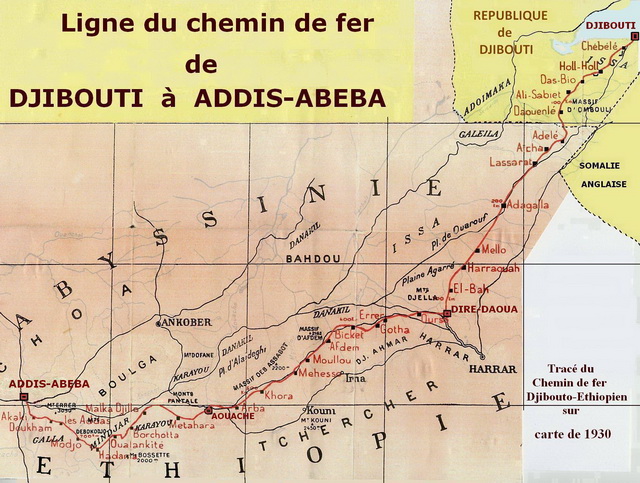HISTORICAL TIMELINE
The Ethiopian Empire, lacking an outlet to the sea, was isolated in the centre of Africa until the end of the 19th century. On 11 February 1893, conscious of the fact that this was a hindrance to the development of his country, His Majesty Emperor Menelik II granted, in a contract with a Swiss engineer named Ilg, the concession of a Railway. This was to be built in three sections: from Djibouti to Harrar, from Harrar to Entotto, then the capital of Ethiopia, and from Entotto to the White Nile through Kaffa.
.jpg) |
.jpg) |
On 27 April 1896 the French authorities granted permission for right of passage via the French coasts of the Somalis.
On 7 august 1896 the concessionary Company, in association with a French engineer, Mr Chefneux, founded the "Compagnie Impériale des Chemins de Fer Ethiopiens", the C.I.E. (The Imperial Railway Company of Ethiopia) and digging commenced in October of that year.
The work began in a troubled barren country with a hostile population. After encountering all types of technical problems, it was decided that the Railway would not, after all, pass through Harrar and Emperor Menelik authorised the construction of the terminus of this first section at Addis-Harrar, located on a plateau lower down.
In 1900 a British Company, Oceana, considered the possibility of building a railway line from the British port of Zeila, in Somalia, to link up with Addis Harrar, demonstrating the interest shown by Britain in the Djibouti Railway. The junction with the line originating in Djibouti would be between the stations of Harraoua and El Bath, about fifty kilometres from the end of the first section.
In order to avoid confusion between Addis-Ababa and Addis-Harrar, the company engineers decided to name the station after a small neighbouring village, "Dire-Dawa". This location was reached on 24 December 1902.
With the first section finished the works advanced across the Awash Valley, a distance of over 430 kilometres, in order to reach the capital Addis Ababa, before heading for the Didessa River some 300 kilometres west of the capital. This river is the main tributary from the left side of the Blue Nile and crosses, or follows, the edges of the very fertile Galla Provinces of Gourague, Nonno, Djimma, Limmou, Rogue and Leka.
At the Didessa river the terminus would be situated near Ilo-Babor, Goumma and Kaffa, some of the richest lands of the western part of the plateau. The completed Djibouti Railway would cover the southern part of the plateau, the most fertile of the Northern provinces.
Faced with financial difficulties, the Imperial Railway Company of Ethiopia filed for bankruptcy on 6 June 1907.
THE BIRTH OF THE FRANCO-ETHIOPIAN RAILWAYS COMPAGNY.
30 January 1908 saw the creation of a new Company: the "Compagnie du Chemin de Fer Franco-Ethiopien", the C.F.E. (Franco-Ethiopian Railway Company), to operate a railway from Djibouti to Addis-Ababa.Work on the line resumed at the end of 1909 and after some four and a half years, on 20 May 1914, it had reached Akaki. On 20 may 1915 after a further three years the capital, Addis Ababa, at an altitude of 2,400m was reached on 17 June 1917. This marked the official commercial opening of the 784 km long railway although the Station of Addis Ababa was not inaugurated until 3 December 1929.
In 1936, during the occupation of Ethiopia, the Italians considered the construction of new routes from Addis-Ababa running as follows :
-Addis-Ababa, Dessie, Adigrat, Massawa: covering 1000km -Addis-Ababa, Dessie, Assab. -Dessie, Gondar, Om, Ager. -Addis-Ababa, Megheli, Dollo, Mogadishu.
All these projects had to be abandoned due to war operations.
In the mid sixties, a 370 km branch line was envisaged which would run from the station of Nazareth towards Dilla in the rich Sidamo Province .This line would partly encompass the route through Addis Ababa and Mogadishu but the project never came to fruition.
The Franco-Ethiopian Railway Company (C.F.E.) was nationalised as part of the Franco-Ethiopian Treaty dated 12 November 1959. This Treaty granted, inter alia, Ethiopian access to the facilities of the Port of Djibouti for all traffic transiting via the Railway. The Treaty was to remain in force until 31 December 2016, the date of expiration of the concession granted by the Emperor Menelik.
On 21 June 1977 the French territories of Afars and Issas acquired their independence and became the Republic of Djibouti.
THE CREATION OF THE DJIBOUTO-ETHIOPIAN RAILWAY.
On 21 March 1981 saw the creation of the "Compagnie du Chemin de Fer Djibouto-Ethiopien", (C.D.E.), the Djibouti-Ethiopia Railway. This is a public bi-national establishment bound by a Treaty signed jointly by the Ethiopian and Djiboutian governments as joint owners. It is managed by a joint board of directors composed of members representing their respective governments.The signing of this Treaty, the constitution governing the Railway and the services it assures between Ethiopia and Djibouti have strengthened the bonds between the two countries. It has improved the economic and social developments of both signatories and the regions around them.
Following the signing of the Treaty the Railway was reorganised, paying particular attention to investment, the acquisition of modern equipment and the repair and rehabilitation of tracks, bridges and tunnels.
On that basis and maintaining the friendly relations between the Ethiopian and Djiboutian governments the C.D.E. worthy heir of the C.I.E. continued the undertaking of Menelik II to modernise his country and open it up to the modern world. The C.D.E. finally ceased all activity in 2011 and the restoration of the line and bridges, begun thanks to the financing of the European Union, was abandoned for various politico-financial reasons.

click on the map
BIBLIOGRAPHY
- "Le Chemin de fer de Djibouti à Addis-Abeba" of Rosanna Van Gelder de Pineda (1995).- "Far wheels" by Charles Small.
- "Vapeur en Afrique" by CP Lewis.
- "Cheminot de Djibouti à Addis-Abeba" by Hubert Pierre Dubois.
- "Chemin de fer Franco Ethiopien de Djibouti à Addis-Abeba" by Jean-Georges Camus (1935).
- "Le ferrovie coloniali Italiane" by Giorgio Gatti.
